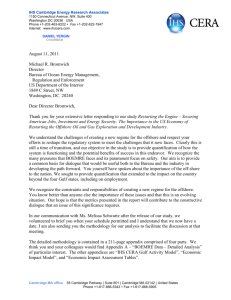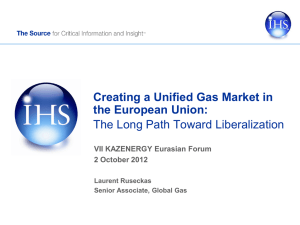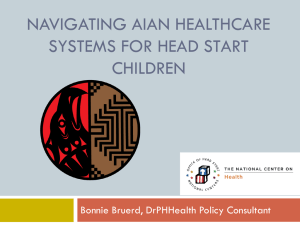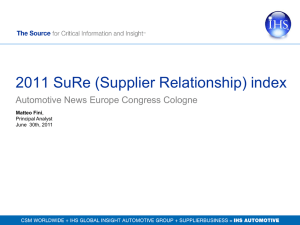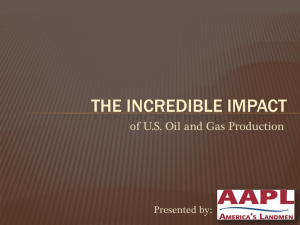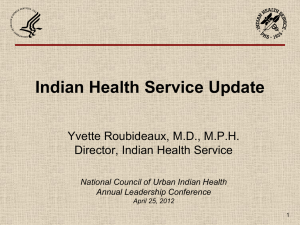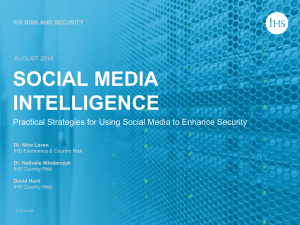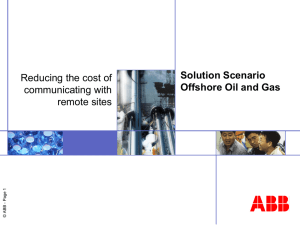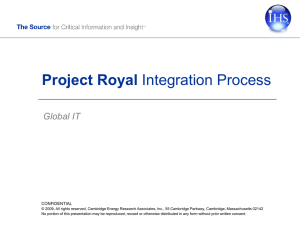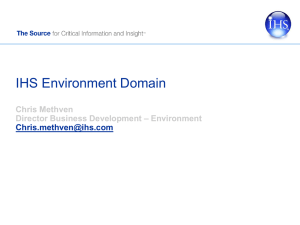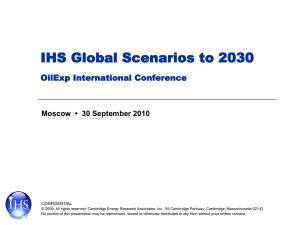View Presentation
advertisement
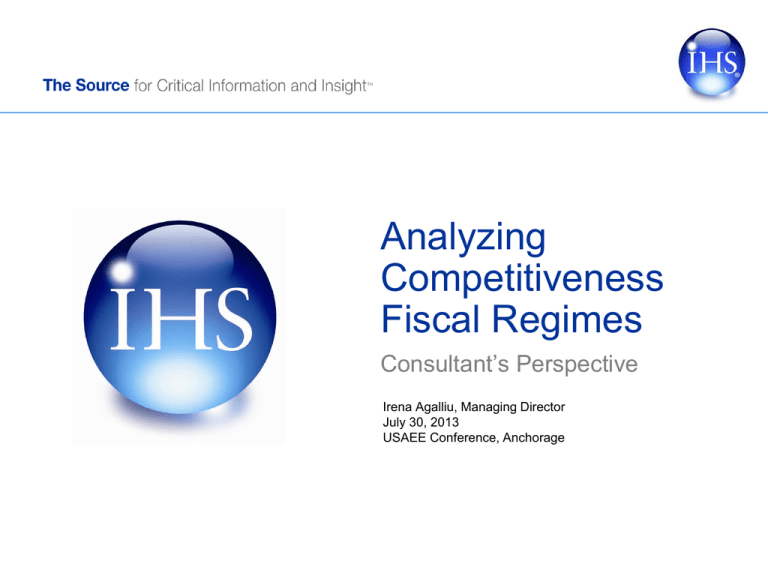
Analyzing Competitiveness Fiscal Regimes Consultant’s Perspective Irena Agalliu, Managing Director July 30, 2013 USAEE Conference, Anchorage Race to the ‘top” or race to the ‘bottom”? © 2013 IHS Why Competitiveness Review? Frence Australia New Zealand Senegal Guatemela Nigeria Algeria Libya Russia East Timor Romania Russia UK Mingolia Falkland Islands Denmark PNG Greece Cambodia 2003 © 2013 IHS Mexico Kyrgystan Germany Ireland China Argentina Belize Ecuador Alaska Ukraine US-GOM Chad Poland Vietnam Thailand Bolivia Guinea Bissau 2004 Colombia Turkey Pakistan Kazakhstan Belize Vietnam Portugal Spain Ukraine India PNG Oman Norway Poland Tanzania 2005 2006 Algeria Benin Poland Venezuela China Argentina Jordan Equatorial Guinea Alaska Bolivia Alberta Ecuador Turkey Indonesia Angola Nigeria Pakistan Libya India Alberta Newfoundland Guinea Bissau Yemen Cyprus DRC Iceland Venezuela Sri Lanka Nova Scotia Niger 2007 Bulgaria Hungary Romania Uzbekistan Azerbaijan Netherlands Russia East Timor Cameroon T&T UK South Africa Oman 2008 Venezuela Colombia Kazakhstan Egypt US-GOM Angola Russia India Indonesia Hungary New Zealand Hungary Yemen Russia Australia Kazakhstan UK Alberta Colombia Ukraine Alaska Malaysia Pakistan Israel Egypt UK India Alberta Brunei Kazakhstan Germany Czech Republic Qatar Pakistan Vietnam 2009 Vietnam Albania Kyrgystan Bangladesh British Columbia Argentina Falkland Islands Tanzania Suriname PNG Turkmenistan Spain Mozambique 2010 Alberta Kazakhstan Indonesia Netherlands Russia Brazil Alaska Uzbekistan Hungary Portugal UK Vietnam Ecuador T&T Israel Yemen 2011 UK Argentina Brazil Russia Norway Alaska Italy Poland Sri Lanka Algeria 2012 2013 Colombia UK Australia Bangladesh India Ukraine Indonesia Myanmar Peru T&T Iraq 3 Objective of Review • Most common objective • “Fair share” or “Fair return” • There is universal consensus that the government and the public should receive a fair share of the revenue from the oil and gas resources. • There is no standard or benchmark as to what that means • Wade Locke – “fair share is a judgment or opinion that can neither be refuted nor proven” • Alberta Royalty Review 2007 – recognized the inherently subjective nature of the fair share concept. • Yet - concluded that Alberta was not receiving its fair share - without properly defining the benchmark or justifying the reasoning for such a conclusion. © 2013 IHS 4 Effective Competitiveness Review • The review is accompanied with market analysis • The peer group is properly identified • Actual finding and development costs are being used • There is a realistic perception of the resource potential © 2013 IHS 5 Market – The Best Indicator $20,000 Interior Revenue from OCS Bonus Payments Bonus $18,000 $4,000 Rents Royalty $16,000 Alberta Royalty Review (2007) Million Canadian Dollars Million Dollars $14,000 $12,000 $10,000 $8,000 $6,000 $4,000 Gas Price Drops to $2.26/MMBtu Royalty Inventives $3,500 $3,000 $2,500 $2,000 $1,500 $1,000 $500 $2,000 $0 $0 2005 2006 2007 2008 2009 2010 2005 Fiscal Year 2006 Source: Alberta DOE and IHS CERA. Source: IHS CERA, data from ONRR 2007 2008 2009 2010 2011 2012 Year Bonus Bid per Acre (US$) $2,500 ACES Introduced $2,000 $1,500 $1,000 $500 $0 2006 2007 2008 2009 2010 Louisiana $377.33 $527.94 $2,321.65 $1,107.16 $1,239.17 British Columbia $358.54 $691.33 $1,383.37 $902.27 $871.16 Texas $413.74 $267.66 $366.16 $277.97 $869.21 Alberta $214.91 $149.28 $182.28 $165.31 $243.66 Wyoming $46.67 $62.06 $77.44 $24.64 $167.85 Alaska $22.86 $15.72 $25.00 $25.89 $14.78 © 2013 IHS Source: IHS CERA 6 Peer Group Selection • • • • • • Similar government objectives Whether the jurisdiction competes for investment in the global or regional market Type of resources Success of the particular jurisdiction in attracting investment Types of investors: global versus small regional investors Common characteristics with respect to • © 2013 IHS • market challenges cost of development 7 Reserves and Price and Cost Assumptions • Size and availability of remaining recoverable reserves • Looking at actual fields in each jurisdiction versus hypothetical oil and gas fields • Reliance on hypothetical models • Limited applicability – mainly theoretical • Finding and development costs – mirror each investment environment • Actual costs • Technological challenges associated with each resource type • Well productivity • Water depth • Distance from market, etc. • Varying Commodity Prices • Different market prices for gas • Price differentials to account for quality of crude © 2013 • IHS Netback pricing to for cost of transportation 8 Selecting the Peer Group – E&P Activity Scorecard E&P Activity Scorecard Field Sizes per New-field Wildcats Brazil High Production Levels High E&P Activity High Exploration Success Russia Venezuela conventional oil and gas China Angola U.S. Texas Norway U.S. GOM deepwater Australia offshore Algeria United Kingdom Oil Production Libya Gas Production Canada (Alberta) Australia (Queensland) No. of New-field Wildcats India Acreage Leased Kazakhstan Canada (British Columbia) No. of Operators Indonesia Oil Reserves Added Malaysia Colombia Gas Reserves Added U.S. GOM shelf Reserves per NFW U.S. Louisiana Success Rate U.S. Alaska U.S. Wyoming Venezuela gas Brazil Angola Australia offshore Norway U.S. GOM deepwater Malaysia Libya China Kazakhstan Algeria United Kingdom India Russia Venezuela heavy oil Indonesia conventional gas Colombia Australia (Queensland) Poland conventional oil and gas U.S. Alaska Canada (Alberta) U.S. Wyoming U.S. GOM Shelf U.S. Louisiana U.S. Texas Poland 0.00 Germany 0.00 Source: IHS CERA © 2013 IHS 0.50 1.00 1.50 2.00 E&P Activity Score 2.50 3.00 20.00 40.00 60.00 80.00 100.00 120.00 Field Size per New Field Wildcat (MMboe) 3.50 Source: IHS CERA 9 140.00 What should be the basis for comparison? GOVERNMENT TAKE GOVERNMENTS EMV IRR © 2013 IHS NPV COMPANIES PI Why not rely on Government Take alone? $3,500 $3,500 $3,000 $3,000 Operating Expenses $2,500 $2,500 $2,000 Investor Net Income $1,500 $1,000 Pretax Cashflow Government Take Project Cash Flow $2,000 $1,500 Capital Expenditure $1,000 Investor Income Income Tax $500 Pretax Cashflow Royalty Bonus $- © 2013 IHS Income Tax 57% $500 Source: IHS CERA Million $ Million $ Capital Expenditure Operating Expenses Government & Investor Split Components of Government of Pretax Cashflow Take 78% Government Take Royalty Bonus $Project Cash Flow Government & Investor Split Components of Government of Pretax Cashflow Take Source: IHS CERA 11 Composite Index Total Jurisdiction Score Weighted Score Index Categories 40 % weight Fiscal Terms 30 % weight Jurisdiction Score Revenue Risk 30 % weight Fiscal Stability © 2013 IHS Index Variables Government Take 25% P/I 25% IRR 25% Progressivity/Regressivity 25% Timing of Revenue 100% Type of Change 20% Nature of Change 30% Degree of Change 40% Frequency of Change 10% 12 Fiscal Terms Index Score 0 • • • • Low Government Take High IRR High PI Neutral Fiscal System Score 5 • • • • High Government Take Low IRR Low PI Regressive/Progressive Fiscal System • Combines government take with measures of profitability • Examines the relationship between project profitability and government take • Regressive fiscal systems • relationship is inverse – government take declines as profitability increases and vice versa © 2013 IHS • Progressive fiscal systems • direct relationship - government take increases as profitability goes up 13 Ranking of Fiscal Systems Venezuela heavy oil U.S. Alaska onshore Russia onshore Canada (Alberta) oil sands Venezuela conventional gas Kazakhstan offshore U.S. Texas onshore Angola offshore Libya onshore U.S. GOM shelf Brazil offshore U.S. GOM deepwater Canada (Alberta) conventional oil U.S. Alaska New Terms China offshore U.S. Wyoming gas U.S. Louisiana onshore gas Australia (Queensland) coalbed gas Germany onshore Colombia onshore Malaysia offshore India offshore Algeria onshore United Kingdom offshore Australia offshore Indonesia conventional gas offshore Indonesia coalbed gas Norway offshore Poland onshore Canada (British Columbia) Government Perspective Gov Take PI IRR Progressivity/Regresivity Revenue Risk Type of Change Applicability of Change Degree of Change Frequency of Change Investor Perspective - Source: IHS CERA. © 2013 IHS 0.50 1.00 1.50 2.00 2.50 3.00 3.50 4.00 4.50 Index Score 14 Is Ranking Sufficient? • Ranking eliminates fields with zero IRR • Perhaps such resources will not be developed • In-depth analysis needs to consider under what terms such fields may become profitable – if at all • Ranking assumes there will be a market for the stranded gas • Is being in the middle of the pack incentive enough to develop the needed infrastructure? • Should the same terms apply to oil and gas? • While ranking provides a measure for comparison, it does not necessarily offer confidence that the system is perceived to be fair by the market forces • . The market test is often the best test for the fairness of a fiscal system – such test is not without risk. © 2013 IHS 15 Questions? IHS Offerings • Specialized Information Databases • Software Information Systems and Intelligence Networks • Publications and Reports • Summits and Conferences • Advisory Services and Research • Consulting Advancing Decision Across the Oil and Gas Value Chain Strategic Planning Exploration and Production Engineering and Construction Midstream and Downstream EHS and Sustainability © 2013 IHS 16
